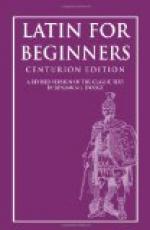[Footnote 2: Genitives and ablatives of description are adjective phrases. When we use an adverbial phrase to tell how long or how high or how deep anything is, we must use the accusative of extent. (Cf. Sec. 336.) For example, in the sentence above multa milia passuum\ is an adverbial phrase (accusative of extent) modifying longam\. If we should omit longam\ and say _a fortification of many miles_, the genitive of description (an adjective phrase) modifying munitionem\ would be used, as munitionem multorum milium passuum\.]
[Illustration: GLADII]
LESSON LXXVII
REVIEW OF AGREEMENT, AND OF THE GENITIVE, DATIVE, AND ACCUSATIVE
448. There are four agreements:
1. That of the predicate noun or
of the appositive with the noun to
which it belongs (Secs. 76, 81).
2. That of the adjective, adjective
pronoun, or participle with its
noun (Sec. 65).
3. That of a verb with its subject (Sec. 28).
4. That of a relative pronoun with its antecedent (Sec. 224).
449. The relation expressed by the genitive\ is, in general, denoted in English by the preposition _of_. It is used to express
{
a. As attributive (Sec. 38).
1. Possession {
{
b. In the predicate (Sec. 409).
2. The whole of which a part is taken (partitive genitive) (Sec. 331).
3. Quality or description (Secs. 443, 445).
450. The relation expressed by the dative\ is, in general, denoted in English by the prepositions _to_ or _for_ when they do not imply motion through space. It is used to express
{
a. With intransitive verbs and with
{
transitive verbs in connection with a
{
direct object in the accusative (Sec. 45).
1. The indirect object { b.
With special intransitive verbs
{
(Sec. 154).
{
c. With verbs compounded with ad\, ante\,
{
con\, de\, in\, inter\, ob\, post\,
{
prae\, pro\, sub\, super\ (Sec. 426).
2. The object to which the quality
of an adjective is directed
(Sec. 143).
3. The purpose, or end for which,
often with a second dative denoting
the person or thing affected (Sec. 437).
451. The accusative\ case corresponds, in general, to the English objective. It is used to express
1. The direct object of a transitive verb (Sec. 37).
2. The predicate accusative together
with the direct object after
verbs of making, choosing, falling,
showing, and the like (Sec.
392).




